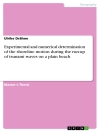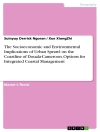This book gathers the most recent scientific research on the geological, geotechnical and geophysical aspects of slope failure in sensitive clays. Gathering contributions by international experts, it focuses on understanding the complete and practical spectrum of challenges presented by landslides in such complex materials. Based on sound and validated research results, the book also presents several recommendations that could be implemented in the guidelines or code-of-practice. These recommendations cover topics including the characterization and behavior of sensitive clays; the pre-failure, failure and post-failure stages of sensitive clays; mapping and identification methods; climate change; hazard assessment; and risk management.
Sensitive clays are known for their potential for causing large landslides, which pose a serious risk to human lives, infrastructure, and surrounding ecosystems within their reach. This has been demonstrated by the recent catastrophic landslides in e.g. Sørum (2016), Skjeggestad (2015), Statland (2014), Byneset (2012), St-Jude (2010), Lyngen (2010) and Kattmarka (2009). The 2015 collapse of the Skjeggestad Bridge in Norway – which was due to a landslide in sensitive clay – alone costs millions of dollars in repairs. Recently, efforts are being made to increase society’s ability to cope with such landslide hazards. Geoscientists are now expected to provide input to the agencies responsible for landslide-risk preparedness. In other words, geoscientists’ role is not only to act as technologists to establish new theories, but also to go the extra mile to implement them in practice, so as to find meaningful solutions to geotechnical problems.
Innehållsförteckning
Landslide in sensitive clays: From Research to Implementation .- Part I: Characterization and behavior of sensitive clays.- Sensitive clays of Eastern Canada: from geology to slope stability.- Chemistry: An Essential Key to Understanding High-Sensitivity and Quick Clays and to Ad-dressing Landslide risk.- Improving the post-failure properties in quick clays by treatment with potassium chloride.- CPTU classification diagrams for identification of sensitive clays.- Relationships between shear wave velocity and geotechnical parameters for Norwegian and Swedish sensitive clays.- Geophysical and geotechnical characterization of a sensitive clay deposit in Brownsburg, Quebec.- Investigating how the changes in geotechnical properties of sensitive clays influence their geophysical properties.- Determination of Remoulding Energy of Sensitive Clays.- Problems related to field vane testing in soft soil conditions and improved reliability of measurements using an innovative field vane device.- A new laboratory procedure to study stress relief in soil samples.- Sample disturbance in deep clay samples.- Effects of sample disturbance in the determination of soil parameters for advanced finite element modelling of sensitive clays.- Viscometric tests of sensitive clay from Byneset, Norway, and fit to the Herschel–Bulkley model.- Dynamic properties of a sensitive clay deposit.- Part II: Pre-failure and failure stages.- The role of instability and shear band localisation in triggering landslides in sensitive clays.- Vibratory roller influence zone near slopes with vibration susceptible soils.- Bayesian updating of uncertainties in the stability analysis of natural slopes in sensitive clays.- Potential Landsliding at the North Spur, Churchill River Valley.- Correction factors for undrained LE analyses of sensitive clays.- Advances in determining Δu and su for Limit Equilibrium analyses.- Recommended practice for the use of strength anisotropy factors in stability calculations.- On the benefits of incorporating anisotropy in stability analyses in sensitive clays.- Development and application of a regional slope stability assessment screening tool .- Part III: Post-failure stage.- The use of Li DAR airborne data for retrogressive landslides inventory in sensitive clays, Québec, Canada.- Runout of landslides in sensitive clays.- Parametric analysis of the mobility of debris from flow slides in sensitive clays.- Mapping quick clay hazard zones: Comparison of methods for the estimation of the retrogression distance.- Modelling of the quickness test of sensitive clays using the generalized interpolation material point method.- Back-calculation of the Byneset flow slide using the Voellmy rheology.- Effect of strain softening behaviours on run-out distance of a sensitive clay landslide.- Part IV: Case records, slides in sensitive sediments including offshore and nearshore slides.- The 1908 disaster of Notre-Dame-de-la-Salette, Québec, Canada: analysis of the landslide and tsunami.- Fv. 287 Strandgata – Kjøreplass bru. Road construction in quick clay.- Case study: Characterization of a thick sensitive clay deposit in the St. Lawrence River valley, slope stability analysis and preliminary assessment of permanent deformations.- Revisiting the 1959 quick clay landslide at Sokkelvik, Norway.- Geotechnical evaluation of a quick clay area in Trondheim, Norway.- Saguenay risk management.- Part V: Sensitive clays mapping and identification.- Development of a methodology for quick clay mapping.- Helicopter electromagnetic scanning as a first step in regional quick clay mapping.- Developments in mapping and web presentation of fjord-marine deposit distributions for quick-clay related work in Norway.- Analysis of ground geophysical, airborne TEM, and geotechnical data for mapping quick clays in Sweden.- Investigation of a sensitive clay landslide area using frequency domain helicopter-borne and ground geophysical methods.- The Norwegian National Database for Ground investigations (NADAG) – a tool to assist in landslide hazard zonation and other quick-clay related issues.- Future strategy for soil investigations in quick clay areas .- Part VI: Hazard assessment and risk management.- Reliability of slopes in sensitive clays .- Natural hazards in a changing climate in Norway.- Development of a long term monitoring network of sensitive clay slopes in Québec in the context of climate change.- Practicing hazard mitigation strategies for a construction on a sensitive clay slope.- Mapping of landslide risks in a changing climate – Development of simplified methodology.- Quick-clay hazard mapping in Norway.- Author index.- Subject index.
Om författaren
Vikas Thakur is professor at the Department of Civil and Environmental Engineering at the Norwegian University of Science and Technology (NTNU). He is expertise in the characterization of soft and sensitive clays, sample disturbances, slope stability, landslides hazard assessment, risk analysis, failure mechanism and strain localization, soft clay stabilization, element testing and physical modelling, finite element modelling, and unsaturated soil mechanics. He is also acknowledge for his pragmatic approaches to bridge the gap between research and practice.
Jean-Sebastien L’Heureux is a senior geotechnical engineer and Technical Lead for landslides at the Norwegian Geotechnical Institute (NGI) in Norway. He has a broad experience from research and consulting projects associated with mapping of landslide hazard and risk assessment on- and off-shore. Jean-Sebastien’s interest include integration of geophysical, geological and geotechnical data for the understanding of soil behaviour, in situ testing and slope processes in sensitive clay terrain.
Ariane Locat is a professor at the Civil Engineering and Water Engineering Department of Université Laval, in Canada. Her main research topic is investigation and characterisation of large landslides in sensitive clays. Her interests include the nature of soil and its mechanical behaviour, slope stability, and risk analysis.












